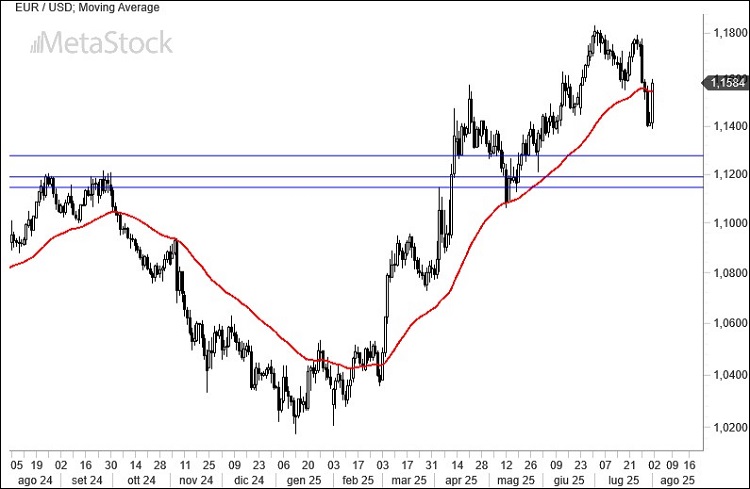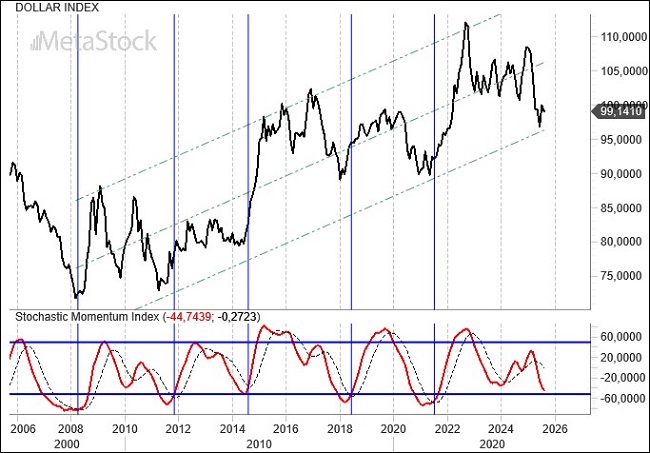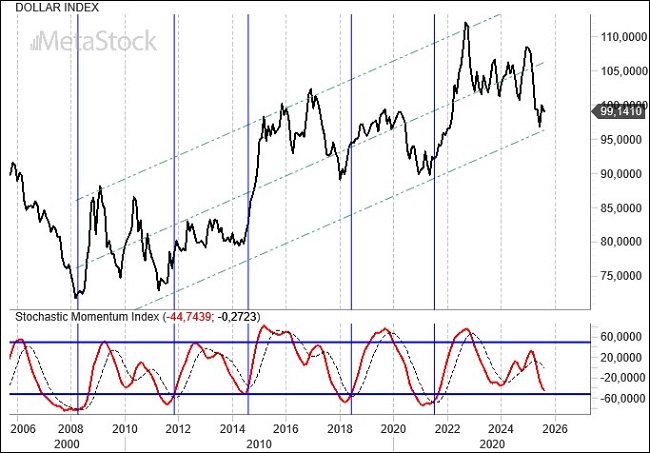- Trade negotiations remain intense, with the latest chapter involving Europe. Meanwhile, some emerging economies remain exposed to possible tariff escalations. The Fed held interest rates steady, but a disappointing U.S. jobs report has reignited speculation over a rate cut in September.
- Europe welcomed the euro’s post-deal weakness, easing pressure on the ECB to pursue further rate cuts.
- EUR/USD pulled back sharply after testing resistance near the 1.18 area. Key support around 1.14 held firm, setting the stage for a strong rebound.
Tariffs Fill U.S. Trade Wars Intensify as Powell Holds Rates and Trump Pressures the Fed
The agreement with the U.S. administration immediately shaved roughly 3% off the euro’s value – primarily due to an overstretched bullish sentiment that had become consistent with a local top.
This correction has temporarily relieved pressure on the ECB to cut interest rates further – a move now expected to be capped at 25 basis points over the next 12 months. Both the ECB and the Fed will likely reassess after the Jackson Hole summit.
Despite the hold, Trump lashed out at Powell, frustrated by the Fed’s refusal to act. Still, the U.S. president expressed confidence that Powell will move in September.
For his part, Powell acknowledged internal dissent within the FOMC but emphasized that upcoming inflation and economic data will be critical, especially as they begin to reflect the impact of tariffs. With July’s employment figures coming in far below expectations, the stage is set for a potential rate cut in the fall.
This could also mark the beginning of a more precise Fed effort to measure inflation expectations in response to tariffs – now 15% on goods from Europe and Japan (even though final deal terms are far from clear). The extension of trade status with China and Mexico offers a more stable outlook, but India and Brazil remain vulnerable, as the U.S. administration continues to blend trade policy with political objectives. Canada and Switzerland were also hit hard by the newly announced measures.
According to Yale’s independent research center, the addition of new EU tariffs raised the U.S. effective tariff rate to 18.2% – the highest since 1934 and up 2.4 percentage points since January 2025. The same study forecasts a 0.5% hit to GDP in 2025 and a 1.8% rise in consumer prices over the short term.
Technical Analysis: EUR/USD Correction and Dollar Weakness
The recent EUR/USD correction sliced cleanly through the 50-day moving average, completing a double-top pattern with a target near 1.14 – precisely where the pair found support.
The 1.12 zone could serve as the next potential landing point, a level where hedges against dollar exposure may begin to reemerge, especially if traders expect the euro bull market to resume. Several major static support levels cluster around this range, possibly slowing further dollar gains.
Still, the dollar didn’t take kindly to the dismal U.S. jobs print, sending EUR/USD quickly back above 1.16. It’s possible the correction may already be over.

A simple trendline analysis of the Dollar Index suggests we may be witnessing the end of a multi-year correction that began in 2022. The lower boundary of a long-term ascending channel – active since the 2008 crisis – has recently come into play.
But not all technical indicators are confirming this view. The Stochastic Momentum Index, for instance, shows that every major bottom in recent years has occurred only when the index dipped into oversold territory. That hasn’t happened yet, and the moving average has just now turned downward.
This points to a likely scenario where the latest rebound gives way to another leg lower, potentially pushing the Dollar Index into a final sell-off phase before it establishes a new primary bottom.

Long-term signals suggest that while the current bounce is notable, the broader dollar downtrend may still have more room to run. Continued economic softness and mounting trade policy uncertainty could maintain downward pressure on the greenback well into the next quarter.


Leave a Reply
You must be logged in to post a comment.